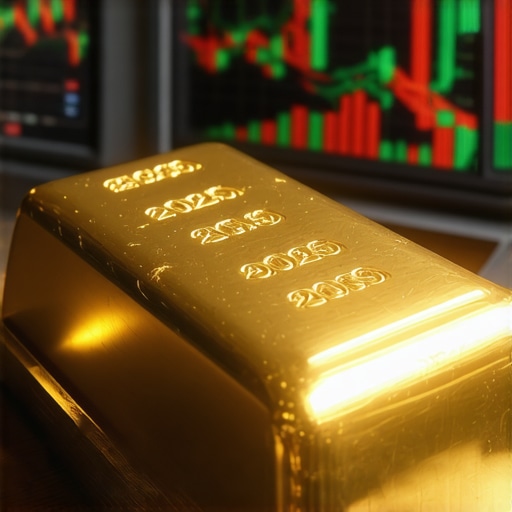Decoding the Complex Dynamics Behind Gold Price Trends in 2025
In the intricate landscape of precious metals investment, understanding what moves gold prices in 2025 requires a multi-dimensional analysis. Gold’s value is influenced not merely by supply and demand but also by macroeconomic policies, geopolitical tensions, currency fluctuations, and evolving investor behavior. This article delves into the sophisticated factors shaping gold price trends, leveraging expert insights and current forecasts to illuminate market mechanics for seasoned investors.
Monetary Policy and Inflation: The Twin Pillars Steering Gold Demand
Central banks’ monetary strategies remain paramount in dictating gold price trajectories. As inflationary pressures persist globally, gold continues to serve as a hedge against currency debasement. The Federal Reserve’s interest rate adjustments, the European Central Bank’s quantitative easing measures, and emerging market central banks’ gold purchasing policies collectively modulate gold’s appeal as a safe haven. Investor sensitivity to real interest rates—adjusted for inflation—directly correlates with gold’s market momentum, influencing speculative and long-term holdings alike.
How Do Global Economic Uncertainties and Geopolitical Risks Affect Gold Prices in 2025?
Geopolitical conflicts, trade tensions, and pandemic aftermaths introduce volatility that often propels gold prices upward as investors seek security. The ongoing shifts in global trade alliances and regional instabilities, particularly in resource-rich areas, contribute to supply chain unpredictability and market anxiety. Such factors amplify gold’s role as a crisis hedge, with price movements reflecting spikes in risk aversion. Additionally, fluctuations in emerging market economies, especially those with significant gold consumption like India and China, introduce demand-side dynamics critical to understanding price oscillations.
Technological and Environmental Factors Influencing Gold Supply Constraints
Mining output and technological breakthroughs in extraction techniques also play a nuanced role. Limited new discoveries coupled with increasing production costs due to environmental regulations impose supply constraints. Innovations in sustainable mining practices and recycling initiatives could alter supply curves, but current trends suggest a tightening market that supports price resilience. These factors, combined with central banks’ strategic reserves management, create a complex supply-demand interplay crucial for forecasting.
Integrating Advanced Analytical Tools for Forecasting Gold Market Movements
Modern investors are increasingly employing algorithmic trading models and data analytics to anticipate gold price shifts. By synthesizing global economic indicators, currency trends, and commodity market data, these technologies enable more precise market timing and risk management. This evolution in trading strategies underscores the importance of mastering gold trading techniques to navigate volatility effectively, as discussed in this expert guide.
Call to Action: Deepen Your Expertise in Gold Investment Strategies
To stay ahead in the 2025 gold market, explore our comprehensive resources on effective gold investment strategies during market uncertainty. Engage with a community of experts and refine your approach to secure and grow your portfolio in this evolving landscape.
For authoritative insights on monetary policy impacts, see the International Monetary Fund’s analysis on World Economic Outlook, which provides foundational data supporting inflation and currency trends influencing gold markets.
Exploring Currency Fluctuations and Their Impact on Gold Price Volatility
Currency exchange rates, particularly the strength of the US Dollar (USD), are pivotal in determining gold price movements. Since gold is globally priced in USD, a stronger dollar generally exerts downward pressure on gold prices, making it more expensive for holders of other currencies. Conversely, a weakening dollar often drives gold prices higher as alternative currencies gain purchasing power. This inverse relationship is not always linear, as geopolitical events and monetary policies interplay to create complex outcomes. Investors who monitor foreign exchange trends alongside gold market signals can capitalize on these correlations for optimized investment timing.
Central Bank Gold Reserves: Strategic Moves Shaping Market Liquidity
Central banks worldwide have increasingly become proactive participants in gold markets, using their reserves as strategic tools to diversify portfolios and stabilize national currencies. Recent years have witnessed significant gold purchases by emerging economies, notably China, Russia, and India, which collectively influence global supply-demand dynamics. The strategic accumulation of gold reserves by these nations signals their confidence in gold’s long-term value as a hedge against geopolitical and economic uncertainties. Understanding central bank policies around gold holdings is essential for investors aiming to anticipate shifts in market liquidity and price trends.
How Can Investors Leverage Technological Innovation in Gold Trading Platforms to Enhance Portfolio Performance?
With the surge of fintech solutions, gold trading has evolved beyond traditional exchanges to include sophisticated digital platforms offering real-time analytics, automated trading algorithms, and blockchain-based transaction security. These technologies empower investors with enhanced transparency, faster execution, and reduced counterparty risks. For instance, algorithmic trading models incorporate macroeconomic indicators and sentiment analysis to generate predictive insights, enabling dynamic portfolio adjustments. Embracing these tools requires a deep understanding of both market fundamentals and technological capabilities, making continuous education imperative. For those seeking to master these techniques, resources such as Mastering Gold Trading: Effective Techniques for New Investors offer invaluable guidance.
Environmental Sustainability and Its Emerging Role in Gold Mining Economics
Environmental regulations and sustainability concerns are increasingly influencing gold mining operations and cost structures. Stricter mandates on emissions, waste management, and land rehabilitation elevate production expenses, potentially constraining supply. Simultaneously, the industry’s pivot toward green technologies and recycling initiatives aims to mitigate environmental impact while maintaining output. Investors attentive to these developments can better assess mining stock valuations and anticipate supply-side constraints affecting bullion availability and pricing.
Incorporating Sentiment Analysis and Behavioral Economics in Gold Investment Decisions
Beyond quantitative factors, investor sentiment and psychological biases significantly shape gold market dynamics. Behavioral economics reveals how fear, greed, and herd mentality drive speculative bubbles or sell-offs, often decoupling prices temporarily from fundamental values. Advanced sentiment analysis tools, leveraging social media trends and news analytics, provide investors with early warnings of market sentiment shifts. Integrating these insights with traditional analysis enhances decision-making precision, especially in volatile periods.
For a comprehensive understanding of gold demand trends amid evolving global economic shifts, consider the detailed market analysis featured at Analyzing Gold Demand Trends to Predict the 2025 Market.
Elevate Your Gold Investment Strategy with Expert Resources
Engage with our extensive collection of expert content to refine your gold investment acumen. Whether you’re navigating market volatility or exploring diversified gold portfolios, our guides such as Top Gold Investment Strategies to Protect and Grow Wealth provide actionable insights tailored to 2025’s evolving landscape. Share your experiences or questions in the comments below to join a vibrant community of gold investors committed to informed and strategic decision-making.
For authoritative perspectives on currency impacts and monetary policies influencing gold, refer to the World Gold Council’s comprehensive reports at Goldhub Research, recognized globally for its analytical rigor and market expertise.
Harnessing Artificial Intelligence and Machine Learning for Superior Gold Price Predictions
In the 2025 investment landscape, the integration of artificial intelligence (AI) and machine learning (ML) is revolutionizing how analysts forecast gold prices. These advanced computational models analyze vast datasets, including macroeconomic indicators, social media sentiment, geopolitical news, and historical price movements, to detect subtle patterns and predict market shifts with unprecedented precision. Unlike traditional econometric models, AI-driven algorithms adapt continuously, learning from new data streams to refine their predictive accuracy. This dynamic approach equips investors with actionable insights to navigate volatile gold markets more effectively.
For example, reinforcement learning techniques enable algorithmic trading systems to optimize portfolio allocations in real-time by simulating various economic scenarios, thereby enhancing risk-adjusted returns. Such sophisticated AI applications underscore the importance of blending quantitative rigor with domain expertise to unlock value in gold markets.
Can Behavioral Finance Principles Be Quantitatively Integrated into Gold Market Forecasting Models?
Behavioral finance, which studies psychological influences on investor decisions, has traditionally been qualitative. However, recent strides in sentiment analysis and natural language processing (NLP) allow for its quantitative incorporation into forecasting models. By systematically capturing investor mood swings via news sentiment indices, social media analytics, and search engine trends, these models can anticipate herd behavior and potential price anomalies in the gold market.
Understanding phenomena like loss aversion, overconfidence, or panic selling through data-driven proxies enables investors to better time entry and exit points. This fusion of behavioral economics with AI tools marks a paradigm shift, offering a more holistic framework that accounts for both fundamental and emotional drivers of gold price volatility.
Macro-Financial Interdependencies: Decoding Complex Global Influences on Gold Prices
Gold price dynamics in 2025 cannot be decoupled from the broader macro-financial environment. The interplay between sovereign debt crises, currency wars, and evolving trade policies creates a mosaic of risk factors influencing gold demand. For instance, escalating tensions in major economies often trigger flight-to-safety flows, boosting gold prices. Conversely, synchronized global growth phases might dampen bullion’s allure as investors pivot toward riskier assets.
Moreover, the advent of digital currencies and central bank digital currencies (CBDCs) introduces a new dimension. CBDCs could alter traditional gold hedging strategies by impacting liquidity and currency volatility. Investors must stay vigilant to these evolving financial architectures to anticipate shifts in gold’s role within diversified portfolios.
Environmental, Social, and Governance (ESG) Trends Reshaping Gold Mining and Investment
ESG considerations have become integral to evaluating gold mining companies and bullion investment vehicles. Increasing regulatory scrutiny and investor demand for sustainable practices compel mining firms to adopt greener technologies and transparent governance frameworks. This shift affects production costs and supply reliability, thereby influencing gold’s market pricing and risk profile.
Furthermore, ESG-aligned gold ETFs and green bonds linked to sustainable mining projects are gaining traction, offering investors ethical exposure without compromising returns. Understanding these nuanced ESG factors helps investors anticipate supply-side constraints and capitalize on emerging investment themes within the precious metals sector.
What Are the Emerging Risks and Opportunities from ESG-Driven Transformations in Gold Markets?
While ESG initiatives promise long-term sustainability, they also introduce transitional risks such as operational delays, higher capital expenditures, and potential regulatory penalties for non-compliance. Conversely, companies that pioneer sustainable mining and recycling innovations may unlock cost efficiencies and new market segments. Investors adept at evaluating these ESG metrics can identify undervalued assets poised for growth amid the green transition.
For authoritative research on ESG impacts in gold markets, consult the World Gold Council’s ESG and Gold Report, which offers in-depth analysis and data-driven insights.
Strategic Implications: Integrating Multidimensional Insights for Enhanced Gold Portfolio Management
Given the multifaceted drivers of gold prices—from AI-enhanced forecasting models and behavioral finance integration to macroeconomic complexities and ESG imperatives—investors must adopt a comprehensive strategy. Diversifying analytical tools, staying updated on geopolitical developments, and incorporating sustainability criteria are crucial steps toward optimizing gold investment outcomes in 2025.
Engage with our advanced resources and expert analyses at Advanced Gold Investment Strategies 2025 to deepen your expertise and refine your portfolio tactics amidst evolving market conditions.
Unraveling AI-Driven Gold Price Forecasting: The Next Frontier in Market Analysis
As artificial intelligence continues to evolve, its application in gold market forecasting transcends traditional boundaries. Machine learning models now assimilate intricate datasets encompassing geopolitical developments, macroeconomic indicators, and even unstructured data such as social media sentiment to produce adaptive and predictive insights. These AI-driven methodologies facilitate the anticipation of abrupt market shifts, enabling investors to recalibrate portfolios dynamically in response to emerging risks and opportunities.
How Can Behavioral Finance Principles Be Quantitatively Integrated into Gold Market Forecasting Models?
Behavioral finance, once a largely qualitative field, is now being quantitatively embedded into gold market models through advanced sentiment analysis and natural language processing. By harnessing data from news outlets, social media platforms, and search engine trends, these models detect investor psychology patterns—such as herd behavior, overconfidence, and loss aversion—that historically precipitate price anomalies. This fusion of psychological metrics with econometric data enhances predictive accuracy, allowing investors to better time market entries and exits while mitigating emotional biases.
Macro-Financial Interdependencies: Navigating Sovereign Risks and Digital Currency Disruptions
Gold prices in 2025 are increasingly influenced by complex macro-financial interdependencies. Sovereign debt concerns, currency devaluations, and evolving trade policies create volatile conditions that directly impact gold’s safe-haven demand. Additionally, the rise of central bank digital currencies (CBDCs) represents a disruptive force, potentially diminishing traditional gold hedging mechanisms by altering currency liquidity and volatility profiles. Investors must integrate these multifaceted variables into their analytical frameworks to maintain portfolio resilience amidst shifting financial architectures.
ESG Imperatives and Their Dual-Edged Impact on Gold Mining Economics
The integration of Environmental, Social, and Governance (ESG) criteria is reshaping gold mining economics profoundly. Stricter environmental regulations and investor demand for sustainable practices escalate operational costs and may constrain supply. Conversely, companies pioneering in sustainable extraction technologies and recycling initiatives are positioned to capitalize on cost efficiencies and emerging ethical investment flows. Investors who master ESG metric evaluation can identify undervalued mining entities poised for growth within this transformative paradigm.
For comprehensive data-driven insights on ESG’s impact in gold markets, refer to the World Gold Council’s ESG and Gold Report, a seminal resource offering empirical analysis and market foresight.
Strategic Synthesis: Leveraging Multidimensional Analyses for Superior Gold Portfolio Outcomes
The confluence of AI-enhanced forecasting, behavioral finance integration, macro-financial complexities, and ESG considerations necessitates a holistic investment approach. Sophisticated investors are advised to diversify analytical tools, maintain vigilance on geopolitical and technological evolutions, and embed sustainability frameworks within portfolio construction. Doing so will enhance risk-adjusted returns and position holdings advantageously within the rapidly evolving gold market landscape of 2025.
Engage with our expert-level content at Advanced Gold Investment Strategies 2025 to refine your tactics and stay at the forefront of market innovation.
Expert Insights & Advanced Considerations
AI-Driven Forecasting as a Game-Changer in Gold Market Analysis
Artificial intelligence and machine learning have moved beyond supplementary tools to become central pillars in forecasting gold price movements. The ability of AI models to assimilate diverse data sources—from geopolitical news to behavioral sentiment—enables investors to anticipate market inflections with heightened precision. Integrating these technologies into gold trading strategies is no longer optional but essential for maintaining a competitive edge in 2025.
Behavioral Finance Quantification: Unlocking Psychological Drivers of Gold Demand
Quantitative incorporation of behavioral finance principles through sentiment analysis and natural language processing bridges the long-standing gap between investor psychology and market data. Recognizing how herd behavior, fear, or overconfidence manifest in real-time allows for more nuanced timing decisions and risk management. This advancement enriches traditional fundamental analysis, providing a more holistic framework for understanding gold price volatility.
The Strategic Impact of ESG on Gold Mining Economics and Investment Portfolios
Environmental, Social, and Governance (ESG) criteria are reshaping gold mining operations and investor decision-making alike. While ESG compliance introduces cost and supply challenges, it simultaneously opens avenues for innovation and ethical investment products. Investors adept at evaluating ESG factors can identify mining companies positioned for sustainable growth, aligning portfolio resilience with emerging market expectations.
Macro-Financial Interdependencies: Navigating Sovereign Risks and Digital Currency Disruptions
Gold’s role as a safe haven remains complex in the context of sovereign debt crises, currency volatility, and the rise of central bank digital currencies (CBDCs). These macro-financial dynamics require sophisticated analysis to anticipate their multifaceted effects on gold demand and liquidity. Incorporating these considerations ensures portfolios remain adaptive and well-positioned amid evolving global financial architectures.
Curated Expert Resources
World Gold Council’s Goldhub Research: A premier source offering comprehensive data-driven reports on gold market trends, ESG impacts, and investment strategies. Its authoritative analyses are indispensable for advanced market participants seeking empirical insights. (Goldhub Research)
International Monetary Fund’s World Economic Outlook: Provides foundational macroeconomic data and projections that underpin monetary policy influences on gold pricing, essential for understanding inflation and currency trends. (IMF WEO)
Advanced Gold Investment Strategies 2025: An in-depth resource covering multidimensional approaches to gold portfolio management, including AI integration, ESG considerations, and macro-financial analysis. (Advanced Gold Investment Strategies 2025)
Mastering Gold Trading: Effective Techniques for New Investors: Offers tactical expertise on navigating volatility with algorithmic and sentiment-driven trading models, a must-read to sharpen execution skills. (Mastering Gold Trading)
Analyzing Gold Demand Trends to Predict the 2025 Market: A specialized analysis focused on demand-side forces shaping price trajectories amid global economic shifts. (Analyzing Gold Demand Trends)
Final Expert Perspective
In dissecting the intricate forces driving gold price trends in 2025, it becomes evident that no single factor operates in isolation. The convergence of AI-enhanced forecasting, behavioral finance quantification, ESG imperatives, and complex macro-financial interdependencies demands a sophisticated, multifaceted approach to gold investment. Mastery of these dimensions enables investors to anticipate volatility, recognize emerging opportunities, and construct resilient portfolios that align with the rapidly evolving market landscape.
For those committed to deepening their strategic understanding, exploring resources such as Advanced Gold Investment Strategies 2025 and engaging with the community of experts will prove invaluable. Share your insights or questions to further enrich the discourse as we collectively navigate the complexities of gold investment in 2025 and beyond.










